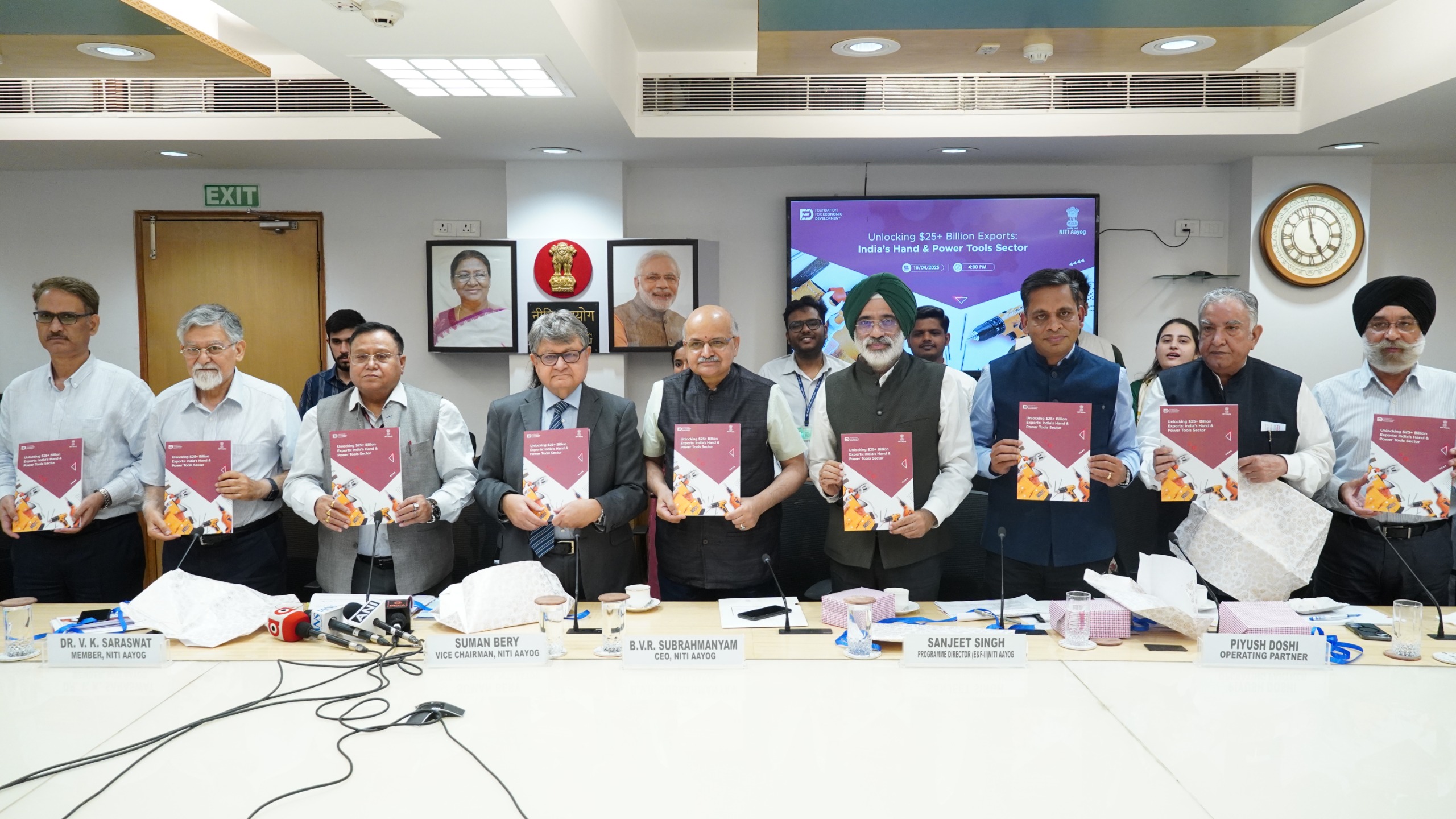- Courses
- GS Full Course 1 Year
- GS Full Course 2 Year
- GS Full Course 3 Year
- GS Full Course Till Selection
- MEP (Mains Enrichment Programme) Data, Facts
- Essay Target – 150+ Marks
- Online Program
- GS Recorded Course
- NCERT- First Ladder
- Polity
- Geography
- Economy
- Ancient, Medieval and Art & Culture AMAC
- Modern India, Post Independence & World History
- Environment
- Governance
- Science & Technology
- International Relations and Internal Security
- Disaster Management
- Ethics
- Current Affairs
- Indian Society and Social Issue
- CSAT
- 5 LAYERED ARJUNA Mentorship
- Public Administration Optional
- ABOUT US
- OUR TOPPERS
- TEST SERIES
- FREE STUDY MATERIAL
- VIDEOS
- CONTACT US
India’s Opportunity in the $100 Billion Global Tools Market
India’s Opportunity in the $100 Billion Global Tools Market

Based on NITI Aayog’s April 2025 Report: “Unlocking $25+ Billion Exports: India’s Hand & Power Tools Sector”
Report Background
- The report was published by NITI Aayog, the central government’s policy think tank.
- It was prepared in collaboration with the Foundation of Economic Development.
- It assessed 18 Indian states and gives a strategic roadmap to scale up India’s tools exports.
Global Market & China’s Dominance
- The global tools market was worth $100 billion in 2022, projected to grow to $190 billion by 2035.
- China holds nearly 50% share, due to large-scale, cost-efficient production and strong global supply chains.
- But now, rising tariffs and increasing costs in China have created an opportunity for India.
India’s Current Status
- India currently exports:
- $600 million in hand tools
- $425 million in power tools
- This is just a tiny share of the global trade, but it shows untapped potential.
What Are Hand and Power Tools?
- These are tools used in drilling, cutting, fastening, etc.
- They are essential across industries like infrastructure, automotive, manufacturing, and household use.
NITI Aayog’s Vision: $25 Billion by 2035
- India can build a $25 billion export-oriented tools industry by 2035.
- To achieve this, bold policy reforms, world-class manufacturing clusters, and public-private collaboration are needed.
Key Recommendations in the Report
- Build globally competitive tool manufacturing clusters.
- Reduce structural cost disadvantages (like energy, logistics, and compliance costs).
- Provide targeted government support, especially for small and medium enterprises (SMEs).
India’s Strengths
- India has low-cost labour, a growing manufacturing base, and strategic trade access.
- These can be used to bridge the 14–17% cost gap with global competitors.
Economic & Social Impact
- NITI Aayog says tools manufacturing can drive inclusive growth, especially in states like Punjab and Maharashtra.
- It can also strengthen MSMEs, increase employment, and reduce dependence on imports.
- NITI Aayog believes India is at a turning point and can become a global leader in the tools industry with the right strategy and reforms.
|
Hand Tools |
Power Tools |
Raw Materials Required |
Infrastructure Required |
|
Screwdrivers |
Electric drills |
Steel and Alloys – for strength and durability |
Forging & Casting Units – shaping metals into rough tool forms |
|
Hammers |
Angle grinders |
Aluminum – used in lightweight power tool bodies and housings |
CNC Machining & Precision Tooling – accurate cutting and shaping |
|
Spanners/Wrenches |
Electric saws |
Plastics and Polymers – for handles, outer casings, switches, insulation |
Heat Treatment Facilities – strengthen metal parts |
|
Pliers |
Nail guns |
Copper and Wires – for electric motors, coils, internal wiring |
Plastic Molding Units – for plastic parts like housings and switches |
|
Saws (manual) |
Heat guns |
Rubber and Grips – for safe, anti-slip handles |
Motor Assembly Units – to build and test internal motors |
|
Chisels |
Power sanders |
Electronic Components – sensors, microcontrollers, switch circuits |
Electronics Assembly Lines – for circuits in smart tools |
|
Tape measures |
Welding machines |
Bearings, Screws, Springs, Small Fittings – for smooth movement and part assembly |
Surface Finishing Units – polishing, painting, chrome plating |
|
Quality Testing & Calibration Labs – check strength & performance |
|||
|
Packaging & Logistics Support – storage, transport, export |




